When I post a photograph, people often ask me which lens I used. I’m happy to tell them, but I don’t think you learn much when someone hands you an answer. I think it’s more instructive to try to guess yourself. Estimating what lens focal length a photographer used can help train your eye to see the world the way the camera sees, and learn how lenses control the sense of depth and perspective in a photograph. And those things will help you find compositions more readily, and make it easier to choose which lens to use in the field.
Wide-angle lenses often create a sense of depth, and immerse you into the landscape, while telephoto lenses flatten the perspective and isolate small parts of a scene. Telephotos are also great for creating patterns. Those traits aren’t always apparent, however, nor are they exclusive. You can show patterns with wide-angle lenses, and you can convey a sense of depth with telephoto lenses. And you can photograph intimate landscapes with wide-angle lenses, and show a vast, sweeping landscape with a telephoto.
Perhaps the best way to tell what focal length was used is to judge the angle of view. In other words, can you see objects that are both above and below the camera, or to the left and right, in the same photo? Then you’re looking at a wide angle of view, and a photo that was made with a wide-angle lens. Or if you seem to be looking at everything in the image from a similar angle, you’re probably looking at the narrow angle of view created by a telephoto lens. Simple enough, right?
So here’s an exercise to help train your eye: try to guess the focal length used to make the photographs in this post. You can estimate the exact number in millimeters (for a full-frame camera), like “28mm,” but that’s pretty difficult, so to make it easier you can just guess the lens category, like ultra wide-angle (shorter than 24mm), wide-angle (24mm to 35mm), normal (between 35mm and 70mm), medium telephoto (70mm to 200mm), or super telephoto (longer than 200mm).
The answers are posted at the bottom, but no peeking until you’ve tried to guess! If you’d like, you can click on an image and post your estimate in the comments. There’s no prize if you get it right – this is just for fun and education.
You can play this game any time you look at a photograph. The more you practice, the better you’ll get at choosing which lens to use in the field — and more importantly, the better you’ll get at seeing like the camera sees, and finding compositions.
— Michael Frye
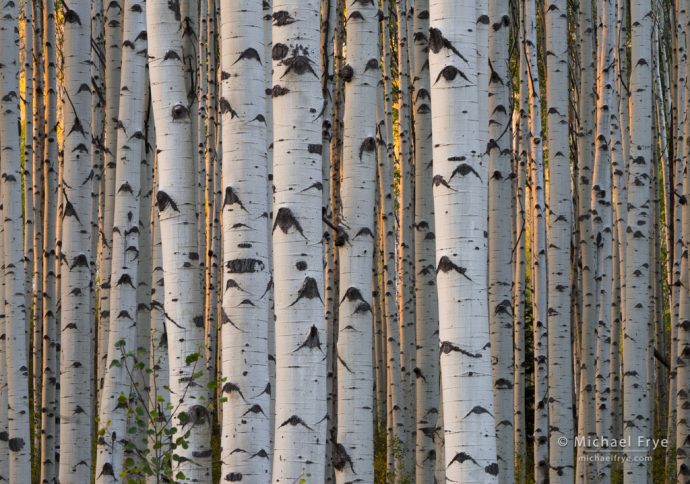
B: Late-afternoon sunlight in an aspen forest, Gunnison NF, Colorado. This should also be pretty straightforward.
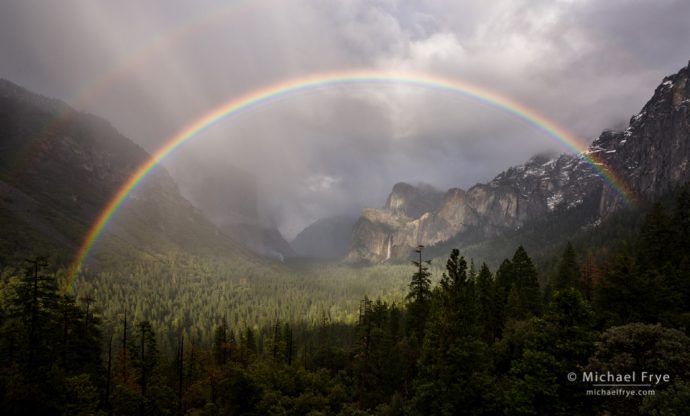
C: Rainbow over Yosemite Valley from Tunnel View, Yosemite. Another one that I think will be fairly obvious.
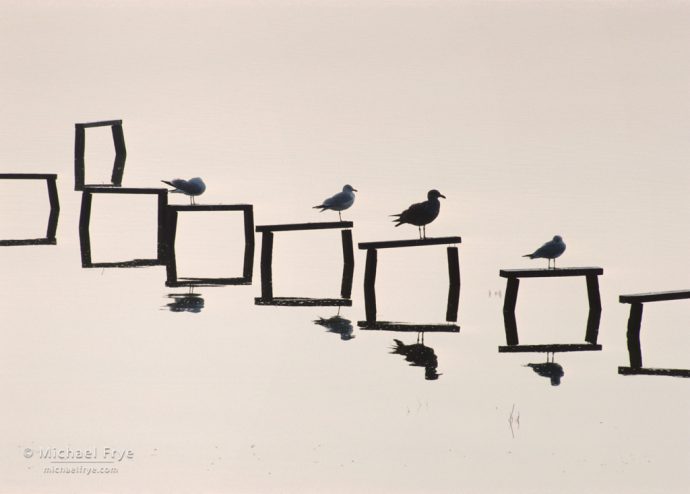
D: Ring-billed gulls and California gull on an abandoned pier, Mountain View Shoreline Park, California. There aren’t many visual cues here about the perspective, or even what you’re looking at – and that lack of context should be a clue in itself. Oh yeah, and there’s a strong pattern. Hmm…
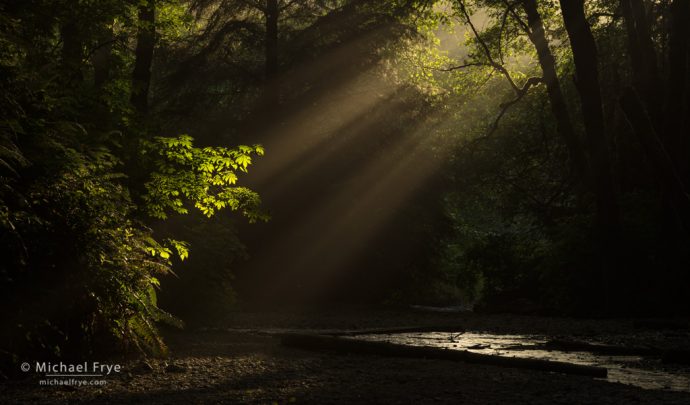
E: Sunbeams at the mouth of Fern Canyon, Prairie Creek Redwoods SP, California. This one might be a little trickier, but think about the angle of view, and what you’re seeing and not seeing (like the sky).
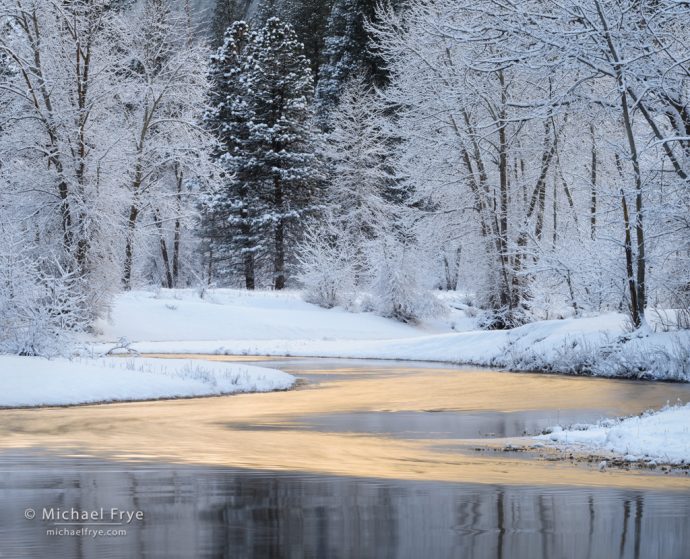
F: Merced River in winter, Yosemite. I hope this one is a little more obvious. Does the space feel expanded or compressed? How far do you think the closest river bank in the lower-right part of the frame actually is from the farthest trees?
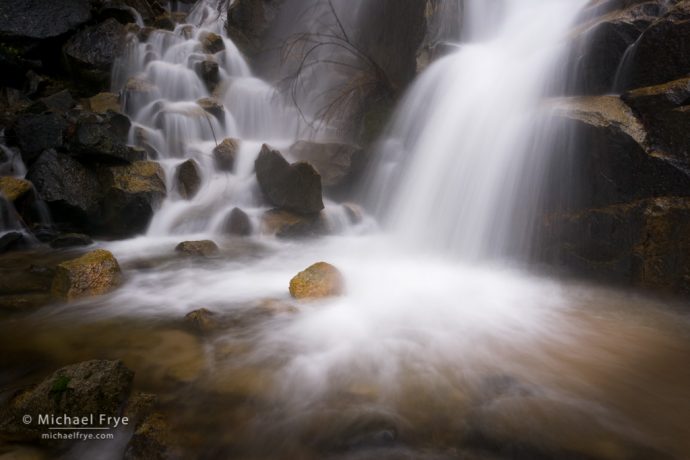
G: Wildcat Fall, Yosemite. Is there a sense of depth in this photo? Depth, or lack of it, is a clue.
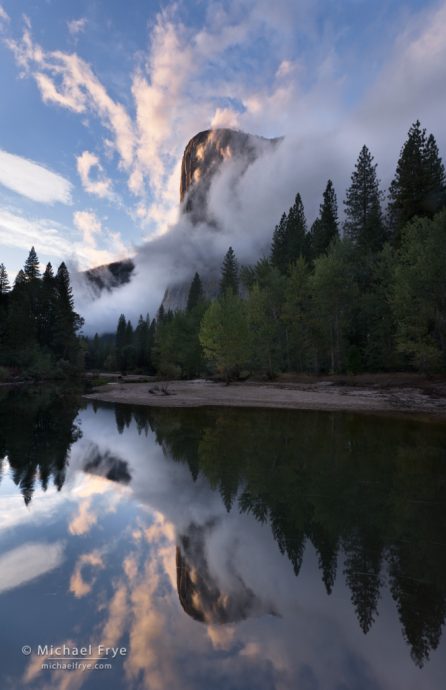
H: Cloud formations, El Capitan and the Merced River, Yosemite. Not much sense of depth here, but again, think about the angle of view.
Answers: A: 16mm; B: 165mm; C: 17mm; D: 300mm; E: 127mm, cropped slightly; F: 127mm, cropped a bit more (equivalent to about 200mm); G: 32mm; H: 19mm; I: 81mm; J: 50mm; K: 70mm.
Related Posts: When Does a Photograph Need a Focal Point?; Composition Fundamentals
Michael Frye is a professional photographer specializing in landscapes and nature. He is the author or principal photographer of The Photographer’s Guide to Yosemite, Yosemite Meditations, Yosemite Meditations for Women, Yosemite Meditations for Adventurers, and Digital Landscape Photography: In the Footsteps of Ansel Adams and the Great Masters. He has also written three eBooks: Light & Land: Landscapes in the Digital Darkroom, Exposure for Outdoor Photography, and Landscapes in Lightroom: The Essential Step-by-Step Guide. Michael has written numerous magazine articles on the art and technique of photography, and his images have been published in over thirty countries around the world. Michael has lived either in or near Yosemite National Park since 1983, currently residing just outside the park in Mariposa, California.

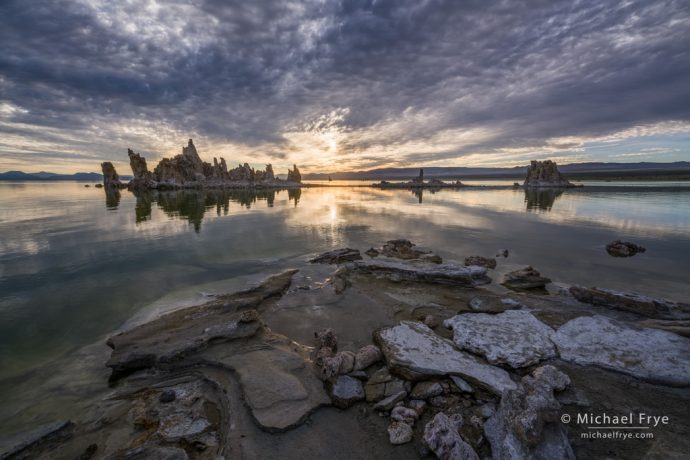
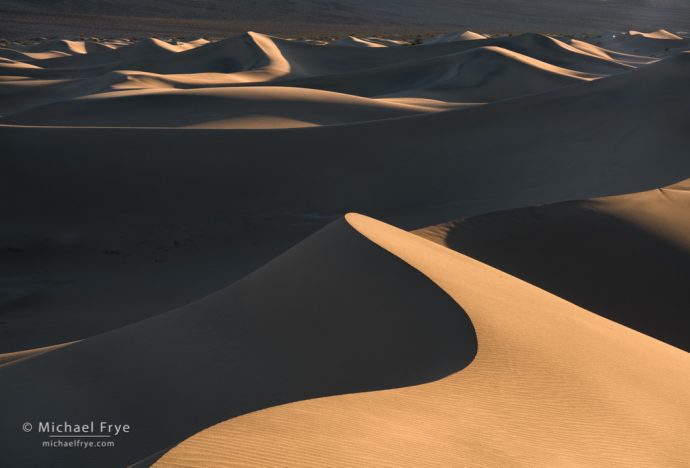
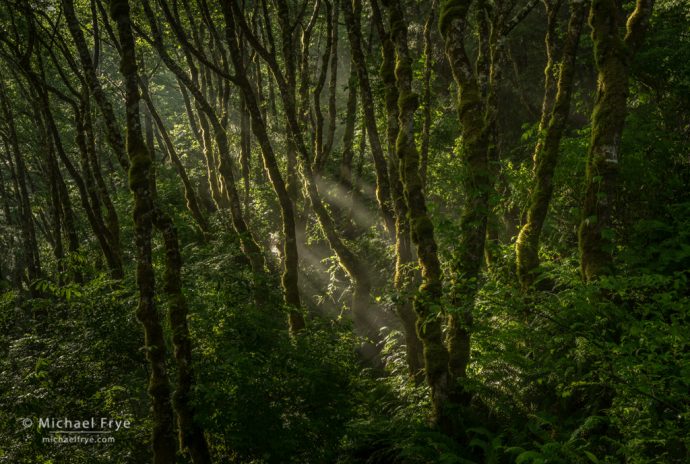
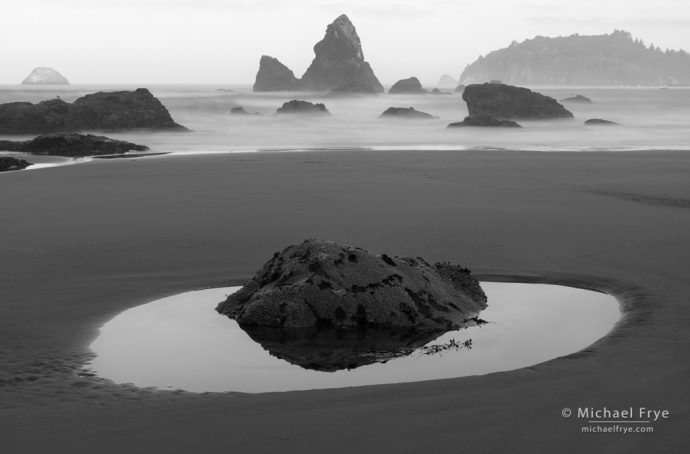








Thanks Michael. This type of exercise is quite thought provoking in helping one understand how to achieve the best composition. Unfortunately for me, it appears I need more practice. 🙂
Lol John. I hope you learned something, and maybe you’ll do better next time. And you can do this exercise with any photo you see.
Well, I did get about half right. But some of the misses were not pretty. 🙂
Well there were some tough ones. The last three especially were chosen because I knew they would be challenging. 🙂
18mm
Well the answers are at the bottom of the post. You’re close on the first one.
Nailed a couple, was in the ballpark for a couple…. was out in the parking lot for several others. 😀 This is a great learning exercise. Thank you!!!
Glad you enjoyed this Jennifer!
Nice exercise. The ultra-wides were relatively straightforward, but past @100mm I found it difficult. More practice needed 🙂
Glad you enjoyed it Eric. It’s pretty hard to distinguish different telephoto lengths, so don’t be too hard on yourself. 🙂
great test for me. I’m just getting started. only got 4 our of 11! yikes. good learning tool
I’m glad you found it helpful, and I’m sure you’ll get better in time.
Good for you, Michael. Takes me back to my start in the ’70’s when books and magazines (what? no internet?) rarely (if ever) published exposure or focal length data … and we had to figure it out as best we could – accompanied by varying amounts of trial and error if we wanted to replicate the look in our own work. I’m working on a how-to seminar for a local photo club with the theme of “Get to know your lenses” with a similar approach to your post here. Well done! (PS. I wasn’t exact on each and every focal length you posted, but I was within an acceptable margin of error for them all.) Thanks for the trip down memory lane.
Thanks Martin. Back in the day, even when books did post information about the lens and settings used I always wondered if they were really accurate. With film you had to rely on memory unless you took meticulous notes. I never took notes, so when a magazine asked me for that kind of information I just took my best guess based on memory. I do have a good memory for what lens I used, but the f-stop or shutter speed… not so much. 🙂
As a side note, John Sexton, one of Ansel Adams assistants, and his workshop coordinator for a number of years (and a tremendous photographer in his own right), told me that Ansel often contradicted himself about what lens he used for some of his most famous images. I can’t blame him, as he was often asked to remember such things about images that he made 50 years earlier!
What a great exercise!!!!! Outstanding!!!!!
Glad you enjoyed it Ted!
Thanks, Michael. This really made me think about something I don’t think of much. I got a few fairly correct, but butchered a few also. I appreciated this thought-provoking exercise.
Happy Holidays!
Been shooting for so long and yet know so little – Thanks Michael!
Looks good. I use alot of wide angle lenses with similar results. Never been able to get sold clarity using long range lenses. How do u get that with the birds. I’ve taken pics of eagles in Alaska and most were not solid, lots of noise no matter how much I turned down my iso. Great photos!
Thanks Stacie. I can’t diagnose your problems with long lenses based on your brief description, but the most common cause of blurry photos with long lenses is camera shake. Yes, even with a sturdy tripod. Telephotos magnify any vibration, so at slower shutter speeds (1/125th or slower) you have to use mirror lockup with a cable release or self timer. I can’t explain why you’re getting noise at low ISOs unless you’re underexposing the photos and then lightening them in software.
Fun exercise. You got me on E and K but otherwise I think I did pretty well:
Guess Actual
A Ultra Wide 17mm 16mm
B Medium Tele 150mm 165mm
C Wide 24mm 17mm
D Super tele 300mm 300mm
E Normal 50mm 127mm
F Medium Tele 135mm 127mm
G Ultra Wide 20mm 32mm
H Ultra Wide 15mm 19mm
I Medium Tele 100mm 81mm
J Normal 50mm 50mm
K Normal 35mm 70mm
You did very well indeed Larry! E and K seemed to fool a lot of people, so you’re not alone.
Thanks for this very timely post Michael. I have just recently begun looking at photos from this perspective. Trying to decide/guess the focal length and f-stop range. It has opened my eye to a whole new dimension when creating a photograph.
I should add your recent exercise in guessing the f-stop is what got me thinking this way. Thanks again, Dave
Hmm… I don’t remember that one! 🙂
Thanks Dave – glad this helped.
Great exercise! Thanks for the wonderful content year in and out.
Thank you Nick!
Michael, thanks for all your post with the great information you share. I do mostly landscape and a couple ago I went from a 15mm to a sharp 24-70 that stays on most of the time!
Marv
You’re welcome Marvin, and thanks!
Great exercise, Michael! I was about 95%, being a slight “millimeter or three” off for some, but at least in close range. But two of them got me! Ironically, I ‘played’ this game with myself recently, as I was preparing a workshop lecture. I was planning to talk about the fact that most of us using zooms don’t have a ‘clue’ what focal length we ended up with when we made the picture, and that as part of mastering the craft, I think it’s important to know this information, i.e. how a particular focal length ‘sees’, because after a while that becomes intuitively connected with your vision of a scene. It also helps you pick the ‘right’ lens if you have to hurry to catch the light!
Well I’m not surprised that you did well Brenda. 🙂 And there were a few that were pretty difficult.
Good point about learning to see how a certain focal length sees. When I first started out in photography I only had prime lenses, and could only afford to buy them one at a time, so I had time to learn how that one particular focal length worked with different kinds of subjects. I think that knowledge has served me well over the years.
Wow I did better thank I though
A: Ultra Wide
B: Medium telephoto
C: Ultra wide
D: Medium Telephoto
F: Super Telephoto
G: Wide angle
H: Super Telephoto
I: Super Telephoto
J: Normal
K: Norma